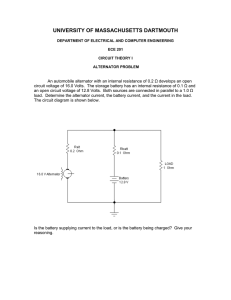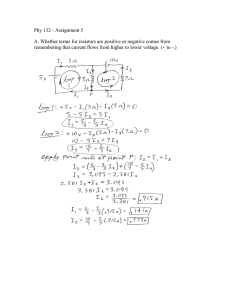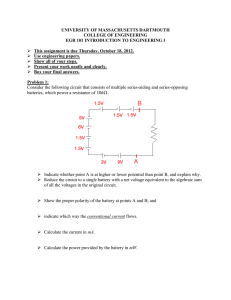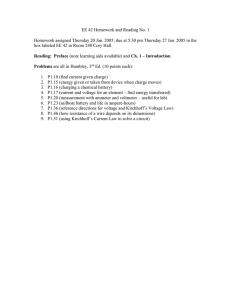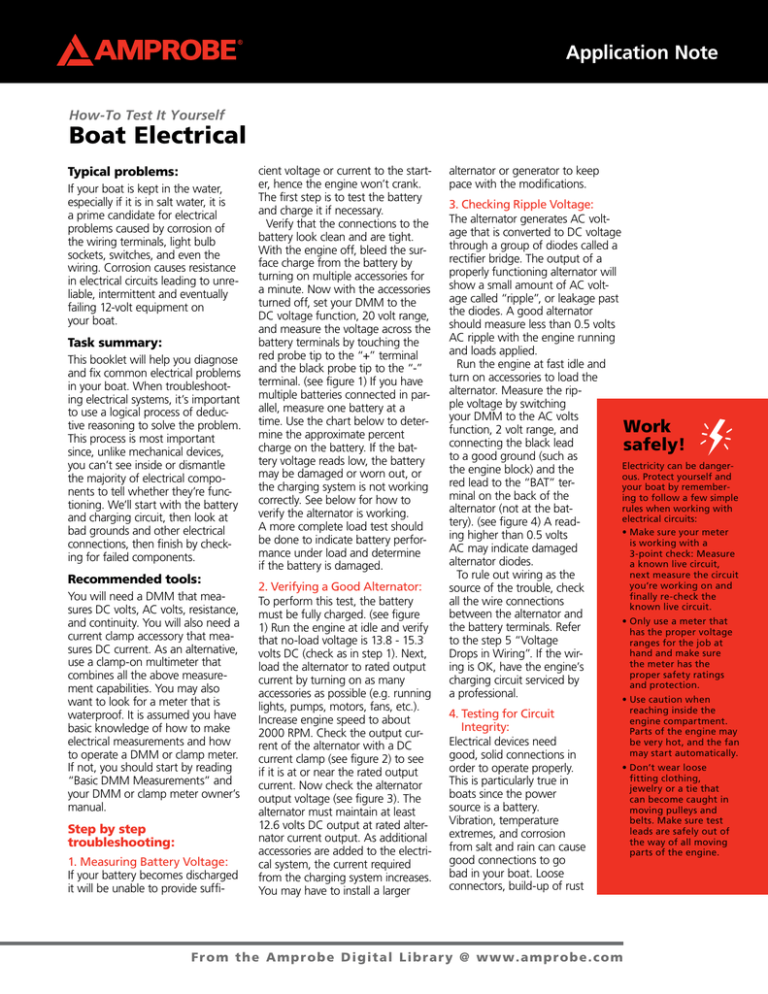
Application Note
How-To Test it Yourself
Boat Electrical
Typical problems:
If your boat is kept in the water,
especially if it is in salt water, it is a prime candidate for electrical
problems caused by corrosion of
the wiring terminals, light bulb
sockets, switches, and even the
wiring. Corrosion causes resistance
in electrical circuits leading to unreliable, intermittent and eventually
failing 12-volt equipment on your boat.
Task summary:
This booklet will help you diagnose
and fix common electrical problems
in your boat. When troubleshooting electrical systems, it’s important
to use a logical process of deductive reasoning to solve the problem.
This process is most important
since, unlike mechanical devices,
you can’t see inside or dismantle
the majority of electrical components to tell whether they’re functioning. We’ll start with the battery
and charging circuit, then look at
bad grounds and other electrical
connections, then finish by checking for failed components.
Recommended tools:
You will need a DMM that measures DC volts, AC volts, resistance,
and continuity. You will also need a
current clamp accessory that measures DC current. As an alternative,
use a clamp-on multimeter that
combines all the above measurement capabilities. You may also
want to look for a meter that is
waterproof. It is assumed you have
basic knowledge of how to make
electrical measurements and how
to operate a DMM or clamp meter.
If not, you should start by reading
“Basic DMM Measurements” and
your DMM or clamp meter owner’s
manual.
Step by step troubleshooting:
1. Measuring Battery Voltage:
If your battery becomes discharged
it will be unable to provide suffi-
cient voltage or current to the starter, hence the engine won’t crank.
The first step is to test the battery
and charge it if necessary.
Verify that the connections to the
battery look clean and are tight.
With the engine off, bleed the surface charge from the battery by
turning on multiple accessories for
a minute. Now with the accessories
turned off, set your DMM to the
DC voltage function, 20 volt range,
and measure the voltage across the
battery terminals by touching the
red probe tip to the “+” terminal
and the black probe tip to the “-”
terminal. (see figure 1) If you have
multiple batteries connected in parallel, measure one battery at a
time. Use the chart below to determine the approximate percent
charge on the battery. If the battery voltage reads low, the battery
may be damaged or worn out, or
the charging system is not working
correctly. See below for how to verify the alternator is working. A more complete load test should
be done to indicate battery performance under load and determine if the battery is damaged.
2. Verifying a Good Alternator:
To perform this test, the battery
must be fully charged. (see figure
1) Run the engine at idle and verify
that no-load voltage is 13.8 - 15.3
volts DC (check as in step 1). Next,
load the alternator to rated output
current by turning on as many
accessories as possible (e.g. running
lights, pumps, motors, fans, etc.).
Increase engine speed to about
2000 RPM. Check the output current of the alternator with a DC
current clamp (see figure 2) to see
if it is at or near the rated output
current. Now check the alternator
output voltage (see figure 3). The
alternator must maintain at least
12.6 volts DC output at rated alternator current output. As additional
accessories are added to the electrical system, the current required
from the charging system increases.
You may have to install a larger
alternator or generator to keep
pace with the modifications.
3. Checking Ripple Voltage:
The alternator generates AC voltage that is converted to DC voltage
through a group of diodes called a
rectifier bridge. The output of a
properly functioning alternator will
show a small amount of AC voltage called “ripple”, or leakage past
the diodes. A good alternator
should measure less than 0.5 volts
AC ripple with the engine running
and loads applied.
Run the engine at fast idle and
turn on accessories to load the
alternator. Measure the ripple voltage by switching
your DMM to the AC volts
Work
function, 2 volt range, and
connecting the black lead
safely!
to a good ground (such as
Electricity can be dangerthe engine block) and the
ous. Protect yourself and red lead to the “BAT” teryour boat by rememberminal on the back of the
ing to follow a few simple rules when working with
alternator (not at the batelectrical circuits:
tery). (see figure 4) A read• Make sure your meter
ing higher than 0.5 volts is working with a
AC may indicate damaged
3-point check: Measure
alternator diodes.
a known live circuit,
next measure the circuit
To rule out wiring as the
you’re working on and
source of the trouble, check
finally re-check the
all the wire connections
known live circuit.
between the alternator and
• Only use a meter that
the battery terminals. Refer
has the proper voltage
to the step 5 “Voltage
ranges for the job at
hand and make sure
Drops in Wiring”. If the wirthe meter has the
ing is OK, have the engine’s
proper safety ratings
charging circuit serviced by
and protection.
a professional.
• Use caution when
4. Testing for Circuit Integrity:
Electrical devices need
good, solid connections in
order to operate properly.
This is particularly true in
boats since the power
source is a battery.
Vibration, temperature
extremes, and corrosion
from salt and rain can cause
good connections to go
bad in your boat. Loose
connectors, build-up of rust
reaching inside the
engine compartment.
Parts of the engine may
be very hot, and the fan
may start automatically.
•D
on’t wear loose
fitting clothing,
jewelry or a tie that
can become caught in
moving pulleys and
belts. Make sure test
leads are safely out of
the way of all moving
parts of the engine.
From the Amprobe Digital Library @ www.amprobe.com
Application Note
and corrosion, broken wires, and
damaged switches are all examples of bad connections.
If a device is not working properly,
first check to make sure it is getting
power. Set your DMM to the DC voltage function, 20 volt range. Connect
the black lead to a good ground and
probe with the red lead on the “+”
input of the device. (Make sure the
ignition switch is turned ON. Many
accessories do not operate with the
ignition turned off.) If the reading is
zero, there is no power to the device.
This could be an indication of a
blown fuse or tripped curcuit breaker.
To check for a blown fuse, first
locate the fuse panel and remove the cover.
To test the fuse, set the DMM to
the DC voltage function and connect
the black lead to a good ground,
then probe both sides of the fuse for
12 volts DC. (see figure 5) A good
fuse will show 12 volts on both sides.
A blown fuse will show 12 volts on
one side only. If you cannot easily
probe both sides of the fuse, as an
alternative you can remove the fuse
and check it for continuity. Set the
DMM to the continuity (ohms) function and probe one side with the
black lead and the other side with the
red lead. A good fuse will sound the
continuity beeper and show almost
zero ohms of resistance. A bad fuse
will not sound the beeper and will
show “OL” for resistance. Replace any
blown fuse only with one of the
same type and current rating.
Suspect connections include terminal
posts, crimp connectors, bulb sockets, switches, and even the wiring
itself.
With all the accessories in the circuit
turned on, probe with your meter, in
the DC voltage function, on either
side of a suspected connector. (see
figure 6) Record the voltage reading
displayed on the meter. If the voltage
drop you measure is too high (more
than 10 % of the battery voltage), try cleaning the contacts by removing
any rust or corrosion, scraping the
metal or wires to expose bare, clean
metal, reseating the connectors, and
securely tightening all screws or nuts.
Repeat this for long runs of wiring
as well. Use your DMM in the DC
voltage function and measure the
voltage drop between the ends of
every section of wire in the circuit. If
you find one section of wiring with
too high a voltage drop it could be
the wire is damaged or corroded, or
the wire may not be the right gauge
(size) for the intended load. Replace
that section of wire, perhaps with a
heavier gauge of wire.
You can calculate the right gauge of
wire to use in a circuit by adding up
the current draw of every device in
the circuit then calculating the maximum voltage drop caused by the
wire itself. If the calculated voltage
drop is too big (more than 380 mV)
then a heavier gauge wire is needed.
The current draw of a device will
either be shown on the device itself,
or for a light bulb, simply divide the
wattage by the nominal voltage, 5. Voltage Drops in Wiring:
12.6 volts. Then use this simple forA bad, or high resistance, connection mula to determine maximum voltage
robs some of the voltage required by drop you will have in the length of
the device you want to run. A typical wire. (See accompanying chart).
12V battery will actually output about
(Ohms per foot from table below) 12.6 volts DC when fully charged. A
x (feet of wire) x (max circuit current)
voltage drop of up to 3 % (0.38 V or = voltage drop
380 mV) for electronics and running
Do this calculation for the total wire
lights, and 10 % (1.26 V) for non-crit- length in the circuit from the positive
ical circuits such as cabin lights is nor- battery terminal all the way through
mal. But if the voltage at a running
the boat back to the negative battery
bilge pump or light is more than 10
terminal.
% lower than the voltage at the battery terminals you could have a
Wire size, or
Ohms per foot
gauge (AWG)
bad connection.
If a device is not operating properly,
16
0.0041 Ω
check all the connections leading up
14
0.0026 Ω
to that device, and back to the bat12
0.0016 Ω
tery. First look for a connector that
has become oxidized and is adding
10
0.0010 Ω
too much resistance in the circuit.
8
0.0007 Ω
2
Amprobe
Boat Electrical
For example, assume a running light
circuit with two bulbs and 40 feet of
wire draws 4 amps. The wiring in the
circuit is 12 AWG. The voltage drop
in the wiring is: (0.0016 x 40 feet x
4 amps = 0.256 V, which is less than
3 % of the 12.6 V battery voltage, so
the wire is adequate. Smaller voltage
drops in the wires mean brighter lighting and less power wasted in the
wires, so it is always OK to use a
heavier gauge of wire for the circuit,
for example using 12 AWG instead of
14 AWG. Oddly enough, the smaller
the gauge number (12 vs 14) the
“heavier” the gauge.
6. Preventing Galvanic Corrosion:
Galvanic or electrolytic corrosion,
sometimes called “electrolysis,” occurs whenever two metals of different types are immersed in water, especially salt water. This is why underwater metal parts such as propeller shafts need a sacrificial zinc
anode attached to them. Zinc is more
active than steel, copper, or bronze
and thus will corrode away instead of the other metal hardware.
All underwater metal parts should
be electrically bonded together inside
the hull with heavy solid copper
grounding wire and secure ground
straps or screws. With all the metal
electrically bonded, every zinc anode
installed below the waterline protects
all the other metal parts from corrosion. Make sure to keep an eye on the
zinc anodes and replace them before
they have fully corroded away.
7. Where to Go From Here:
With the help of the tips and techniques in this booklet, you should be
able to troubleshoot most of the common electrical problems on your
boat. When troubleshooting electrical
systems, it’s important to use a logical
process of deductive reasoning to
solve the problem. Jumping to conclusions can be expensive and time consuming. Just use this simple
approach: check for power, check
fuses and switches, check connections, and check for good grounds.
(continued on page 3)
Application Note
Troubleshooting boat electrical systems
ON/OFF
V
2
750 200
20
A
A
V
200m
A
200m
20m
20A
2m
A
200μ
Hz
200k
20M
2M
200k
Ω
VΩ
2
V
V
HOLD
1000
200
20
200m
200μ
2m
20m
20A
200m
20k
2k
Ω
Hz
20k 2k 200
VΩ
COM
mA
COM
mA
20A
20A
HOLD
A
PEAK
600
A
400 OFF
400
600
400
V
600
DCA
ZERO
V
Hz
600
600V
figure 1
V
V
MAX
CAT
III
V
600V
COM
figure 2
figure 3
ON/OFF
V
V
A
V
A
2
HOLD
1000
200
20
750 200
20
200m
2m
20m
20A
200m
A
Hz
A
Hz
Ω
Ω
VΩ
COM
mA
VΩ
COM
mA
figure 5
A
200μ
20k
2k
Hz
20k 2k 200
20A
VΩ
figure 4
V
200m
200k
20M
2M
200k
Ω
20A
2
200m
20m
20A
2m
200μ
A
COM
mA
20A
figure 6
Amprobe® Test Tools
www.Amprobe.com
info@amprobe.com
Everett, WA 98203
tel: 877-AMPROBE (267-7623)
Amprobe® Test Tools Europe
Beha-Amprobe GmbH
www.Amprobe.de
info@amprobe.de
In den Engematten 14
79286 Glottertal, Germany
tel: +49 (0) 7684 8009 - 0
3
Amprobe
Boat Electrical
©2008 Amprobe Test Tools.
All rights reserved. Printed in the U.S.A.
09/08 3365556 Rev A

